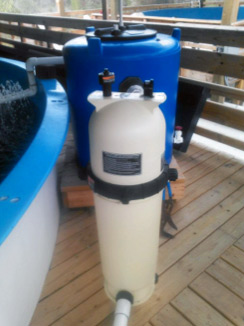From the ferocious great white shark (Carcharodon carcharias) to the graceful white-spotted eagle ray (Aetobatus narinari), Elasmobranchii are a diverse group of boneless fishes that are circumglobal, inhabiting a diverse array of habitats, temperature ranges, salinity, and niches in the world’s oceans and rivers.
It is no wonder that these unique creatures, while usually boasting relatively bland coloration compared to the typical teleostei reef fishes, pique the interest of pretty much every hobbyist. This group of fish definitely has its challenges but, with proper information and species selection, can be kept fairly easily by a moderately skilled aquarist with a generous budget.
Another elasmobranch curveball
So your system is all coming together. You have the appropriate space and the ability to provide appropriate food and nutrition. But elasmobranchs throw another curveball at aquarists. As with a messy two-year-old, their waste and leftover food are a concern that must be addressed by providing good filtration for an elasmobranch system.
Tap out
It starts with the source water. Reverse-osmosis, de-ionized (RO/DI) water is definitely a great tool in this aspect, but not always necessary depending on your tap water. Be mindful of nitrate, phosphate, nickel, and copper in your source water, as these compounds can cause issues for elasmobranchs. It usually is a good idea to use a quality RO/DI unit to keep these values to a minimum. A TDS (Total Dissolved Solids) meter can be employed to ensure that the unit is working properly.

Out with the old, in with the new!
With good-quality source water secured, keeping the water clean in the tank becomes the focus. Usually a tank, pool, or pond of substantial size is used to house elasmobranchs. This demands a unique take on filtration:
Redundant pumps
A large pump for good turnover is extremely important to run all this filtration. I generally like to employ two main pumps—one as a primary pump and one as a backup pump because failure of all flow in an elasmobranch system can mean a tank crash faster than one would think. I recommend 10x turnover or more for proper oxygenation and degassing of carbon dioxide.
Mechanical filtration

A tank dedicated to elasmobranchs generally relies on mechanical filtration to a much greater extent than a reef system does. Capturing waste and removing it quickly before it can rot is the focal point of a good filtration system for sharks and rays.
Most large systems employ sand or bead filters designed for swimming pools to provide mechanical filtration. The only downside is they need to be backwashed frequently to remove detritus before it rots, which can waste some water if not planned around water changes.
Unnecessary saltwater use can be avoided if a freshwater line can be plumbed into the sand filter. The freshwater line is used for the main backwash, and then you switch to system water. This means that only the end of the backwash is salt water but the detritus is properly flushed out of the system.
Oversized skimmer
An oversized protein skimmer helps mechanically remove smaller debris that makes it past your sand filters, reducing nitrate production within the system. An added benefit is that it also boosts oxygenation within the system, which is extremely important for large elasmobranchs. If you are willing to spend the money, you can rely on an extremely large fractionator to do the bulk of your mechanical filtration versus a sand filter.
Biological filtration
Some biological filtration should also be employed, since most ray and shark tanks often have minimal live rock to fall back on for bacterial processes. Bio-towers packed with bio-media, such as bioballs, are efficient and can be plumbed inline after a sand filter.

Algae at work
Large refugia or vegetable filters can also work well for nitrate reduction. Chaetomorpha is a great choice for a refugium, and turf algae scrubbers are also efficient at removing nitrates and phosphates from the system, making algae within the tank or pool less prevalent.
Chemical filtration
If refugia cannot be used due to space constraints, the binding of heavy metals and the removal of phosphates and nitrates can be achieved with chemical filtration. At the very least, a small amount of high quality carbon should be employed to remove impurities.
Plan and organize
Most importantly, your filtration needs to be planned and organized. A well-thought-out system should be easy to maintain. Keep in mind that:
- Mixing vats for salt water should be sufficiently large so you always have enough salt water on hand to perform a significant water change in a short amount of time.
- Each part of your filtration system should be easy to access for proper maintenance.
- You should be able to bypass and replace every part of your filtration system in a fairly short amount of time.
All of these steps will ensure success with your new passion for keeping elasmobranchs.
See Part 1 of the Elasmobranch Enthusiasts series on aquarium space needed, Part 2 on diet and proper nutrition, and Part 4 on reproduction.



